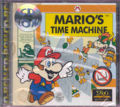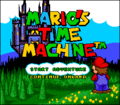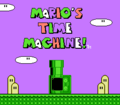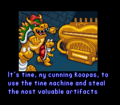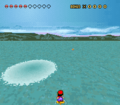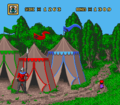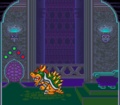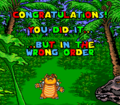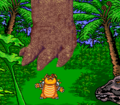Mario's Time Machine: Difference between revisions
m (→Logo) |
|||
| Line 311: | Line 311: | ||
===Logo=== | ===Logo=== | ||
<gallery> | <gallery> | ||
MariosTimeMachineLogo.png | MariosTimeMachineLogo.png|Logo | ||
</gallery> | </gallery> | ||
Revision as of 04:33, February 21, 2022
| It has been suggested that this page be split into the following: Mario's Time Machine, Mario's Time Machine (Nintendo Entertainment System). (discuss) |
Template:Infobox Mario's Time Machine is an edutainment title developed by Radical Entertainment that was released for MS-DOS and SNES in 1993; it was later released for the NES in June, 1994[1] alternatively spelled Mario's Time Machine! It is the successor of Mario is Missing! It is meant to teach younger players basic world history and is the last Mario Discovery series game before discontinuation. The original PC release was distributed through floppy disks, but there was a Deluxe version provided as a CD-ROM in 1994 which added voice acting and a Library reference file featuring Bowser's mother.
Story
In the year 1993 (1994 in the Deluxe re-release), Bowser uses a time machine (called a "Timulator"), traveling backwards to different points in human history and stealing significant artifacts to place in his personal museum inside his castle. With his collection nearly completed, Bowser gloats that not even Mario can stop him now. Mario realizes that history will change forever if he does nothing, so it is up to Mario to use Bowser's own device against him by returning the artifacts to their proper places in time.
The home console manuals add that Bowser plans to destroy his time machine, deliberately planning to irreversibly damage history and send the world back to the Dark Ages.[2] In the NES game, Bowser's Museum has been fully built and already established itself with history's greatest artifacts. Yoshi joins Mario in his quest to stop Bowser's plot, but instead gets captured when he scouts ahead. In addition to fixing the timeline, Mario must also rescue Yoshi from peril.
Gameplay
MS-DOS
The central hub of Mario's Time Machine is the museum within Bowser's castle. The museum is three floors high, and on each floor lies five artifacts, giving Mario a total of fifteen periods of time to travel to. Mario must take an artifact from a pedestal, look at the date and location labeled on it, and then program that information into the time machine and travel to that point in the timeline. Mario surfs the ripples of time, collecting mushrooms and avoiding hazards.
When the player arrives in the time period, he must explore and converse with the various residents that live there. In doing so, the player learns about the artifact, the time period, and the person associated with it. To get more information, the player must receive items that some residents possess and give them to others in order to satisfy their needs. For example, in Vienna, one resident will complain about the heat until Mario retrieves a fan and hands it to the person, who will then continue to give information. After the player has talked to everyone, the player fills out a History answer sheet. The answer sheet consists of a two-page biography about the person associated with the artifact and the time period, with blanks replacing several words. The player must use the information they received to correctly fill in the blanks. If the player fills in the wrong answer more than twice, they are forced back into the present; if they succeed, Mario can return the artifact to its owner and return back to the present. After all of the artifacts on a floor have been returned, Mario moves upward to the next floor.
There are three different endings which are decided by how many points the player has scored and the order in which the artifacts are returned. If the player spends too much time returning all the artifacts or returns any artifacts in the wrong order, there is a non-standard Game Over in which Bowser escapes to "Paradise" using the time machine; or Mario gets sent to the Cretaceous Period where he looks in different directions of the screen (both being notable for being the only ways to get a Game Over). A message reminding the player to return all the artifacts either in a more timely manner or in the correct order appears on the screen. After that, the player must start over from the beginning, or use a password to go back to a previous point. However, if they meet these two objective conditions, the time machine overloads, self-destructs and sends Bowser to the Cretaceous Period where he gets stepped-on by a Tyrannosaurus Rex (humorously, right beforehand when he notices it, his eyes shrink with realization of what will happen to him and he meekly opens an umbrella in the hopes it will protect him), and a raptor then grabs his squished remains and throws them like a Frisbee.
SNES
Being a port of the PC release, the SNES version has a few changes to the original game. There is less content overall, so Mario travels to fewer time periods, and there are some graphical changes such as the design of the time machine. During the sequence on time's waves, Mario can move in all directions rather than just forward due to the use of Mode 7 on the water, and he must go in a whirlpool after collecting ten mushrooms. The true ending is similar to the DOS version, only Bowser's puddle remains on the ground throughout the entire credits, and in addition, Bowser only gapes upon noticing the T-Rex foot coming down on him.
NES
Unlike Mario is Missing!, the NES release is virtually a different game with little resemblance to its previous incarnations, traveling to very different time periods and restoring entirely different objects. Bowser's Museum is largely a hall with seven doors ending with Bowser's chamber. Behind each door is a Mario Bros.-style mini-game involving Koopas with a unique item that can be acquired if Mario defeats all of them. The Timulator is in the bottom center of each room, and it is a Warp Pipe with a transparent box. Inside the Timulator, Mario can select pre-determined time periods rather than input them manually, although the location is not disclosed. Once warped across time and space, Mario will arrive at a short platforming land with enemies (Koopas, Bodyslam Koopas, and Walking Turnips) and occasionally indigenous inhabitants of the time period. There are also information boxes which describe the location. Mario must take the item acquired in the mini-game and return it to the appropriate spot - if it is in the incorrect place then it will return to the clutches of the Koopas via a bird (or flying saucer when on the moon), but if Mario is right then he will complete that area. There are two artifacts in each door, so Mario must enter a door at least twice before he can close that section of the museum. After all the doors of the museum are cleared, the deeper part of the castle is available after Mario passes a random History Test about what he's learned. After beating Bowser, a key will be released and Mario will free Yoshi from his cage. In the end, Mario and Yoshi pose next to a saddened, crying Bowser.
Time periods
The time periods that Mario visits in each version varies. Here is a chart of the location and artifact for the PC, SNES and NES versions in chronological order.
PC
- 369 BC — Athens (Plato's Republic)
- 47 BC — Alexandria (Cleopatra's Staff)
- 105 AD — Luoyang (Ts'ai Lun's Bamboo)
- 1292 — Gobi Desert (Marco Polo's Print Block)
- 1429 — Orleans (Joan of Arc's Shield)
- 1455 — Mainz (Johann Gutenberg's Metal Type)
- 1503 — Florence (Michelangelo Buonarroti's Chisel)
- 1505 — Florence (Leonardo Da Vinci's Notebook)
- 1521 — Pacific Ocean (Ferdinand Magellan's Astrolabe)
- 1595 — London (Queen Elizabeth I's Crown)
- 1601 — Stratford-upon-Avon (William Shakespeare's Skull)
- 1610 — Padua (Galileo Galilei's Telescope)
- 1687 — Cambridge (Isaac Newton's Apple)
- 1752 — Philadelphia (Benjamin Franklin's Key)
- 1776 — Philadelphia (Thomas Jefferson's Declaration of Independence)
- 1791 — Vienna (Wolfgang Amadeus Mozart's Flute)
- 1824 — Vienna (Ludwig van Beethoven's Music)
- 1831 — London (Michael Faraday's Magnet)
- 1843 — London (Charles Dickens' Inkwell)
- 1863 — Washington (Abraham Lincoln's Spectacles)
- 1879 — Menlo Park (Thomas Edison's Filament)
- 1885 — Paris (Louis Pasteur's Flask)
- 1915 — Tuskegee (George Washington Carver's Crank Handle)
- 1947 — Calcutta (Mahatma Gandhi's Flag)
- 1993/1994 — Novato (David Grenewetzki's Floppy Disk)
SNES
- 369 BC — Athens (Plato's Republic)
- 47 BC — Alexandria (Cleopatra's Staff)
- 1292 — Gobi Desert (Marco Polo's Print Block)
- 1429 — Orleans (Joan of Arc's Shield)
- 1455 — Mainz (Johann Gutenberg's Metal Type)
- 1503 — Florence (Michelangelo Buonarroti's Chisel)
- 1505 — Florence (Leonardo da Vinci's Notebook)
- 1521 — Pacific Ocean (Ferdinand Magellan's Astrolabe)
- 1595 — England (Queen Elizabeth I's Crown)
- 1601 — Stratford-upon-Avon (William Shakespeare's Skull)
- 1687 — Cambridge (Isaac Newton's Apple)
- 1776 — Philadelphia (Thomas Jefferson's Declaration of Independence)
- 1824 — Vienna (Ludwig van Beethoven's Music)
- 1879 — Menlo Park (Thomas Edison's Filament)
- 1947 — Calcutta (Mahatma Gandhi's Flag)
NES
- 80M BC — Cretaceous Period (Dinosaur Egg)
- 776 BC — Olympia (Torch)
- 31 BC — Egypt (Cleopatra's Throne)
- 1192 — Japan (Minamoto no Yoritomo's Sword)
- 1520 — The Trinidad (Ferdinand Magellan's Steering Wheel)
- 1602 — United Kingdom (William Shakespeare's Quill Pen)
- 1687 — Cambridge University (Isaac Newton's Apple)
- 1862 — Gettysburg (Abraham Lincoln's Stovepipe Hat)
- 1879 — Menlo Park (Thomas Edison's Light Bulb)
- 1903 — Kitty Hawk (the Wright brothers' Propeller)
- 1905 — Germany (Albert Einstein's Physics Equation)
- 1947 — India (Indian Flag)
- 1969 — Moon (American Flag)
- 1989 — Berlin Wall (Sledgehammer)
Historical inaccuracies and other errors
Despite Mario's Time Machine being intended as an educational game, it contains many errors in regards to its historical facts.
- Alexandria (47 BC)
- This section centers on returning Cleopatra's staff to her so that she can reign over Egypt; however, she first reigned in 51 BC (despite one of Cleopatra's guards saying that she was "crowned" in 52 BC) at the bequest of her father and alongside her brother, Ptolemy XIII. She then took sole control after a civil war between her and her brother in 47 BC.[3]
- Cleopatra also says that her staff was passed down from her ancestors, although no such item exists in real life.
- Julius Caesar claims that he is allergic to cats; though his family line, in general, was afflicted with asthma,[4] Caesar is not known to have been allergic to or even afraid of cats.[5]
- Caesar also boasts about having conquered Pompeii, despite the town having been acquired by Roman general Sulla during the Social War in 89 BC,[6] before Caesar held any power.
- One of Cleopatra's guards asks Mario to give one of Cleopatra's handmaidens a Wooden Snake to demonstrate his love for her, and after receiving the gift, she makes a comment about being bitten by the "love scarab". Neither animal is associated with romance or love: snakes are the aggressive guardians of royalty,[7] that can also symbolize chaos.[8] and scarabs symbolize the arrival of the Sun and the reincarnation of humans[9]
- Throughout several lines of dialogue, it is stated that "Ptolemy XI" is Cleopatra's father and "Ptolemy XII" is the brother that campaigns against Cleopatra. However, the numbers in their names are off by one: Ptolemy XII was the father and Ptolemy XIII was the brother.
- Several characters also use dates with before Christ, for example when the handmaiden says that Caesar arrived in Egypt "in 48 B.C.". Though these dates are not incorrect, they would have not been used by people who lived close to fifty years before the birth of Jesus, and furthermore, this dating system was not created until 525.
- The history pages mention that Cleopatra had three sons with Mark Anthony, despite one of them, Cleopatra Selene II, being female.
- Athens (369 BC)
- Aristotle is depicted as an old man in-game, but as Aristotle was born in 384 BC,[10] he would have only been fifteen years old. With that in mind, the rest of the interactions with him become anachronistic, as he only became Plato's student when he was seventeen or eighteen,[11] and thus, he has not yet formulated any of the theories that are discussed in-game.
- A councilman mentions that Plato's Academy was founded "in 387 B.C." - while technically correct, a dating system based on Jesus would not have been used by someone who lived over three hundred before he was born.
- The same councilman also claims that the Academy will last for over nine hundred years. In reality, the Academy was destroyed in 86 BC.[12]
- He also does not know whether the god of wine's name is Dionysus or Bacchus, despite "Bacchus" being the name adopted by the Romans.
- The history page describes the Academy as the first "university", which is incorrect as it did not offer any degrees to its students.
- Cambridge (1687)
- The discovery of calculus is attributed uniquely to Newton, despite Gottfried Wilhelm Leibniz also discovering calculus around the same time as Newton, albeit independently; this led to a debate as to who should receive recognition for the discovery.[13]
- Several characters state that Newton's Principia has not yet been published, for example, when Edmund Halley says that he is still working on the rough draft, but the book was published on July 5,[14] even though the game takes place on December 25.
- Halley also says that he tracked a comet orbited around the Earth in 1862. This is a typo; the comet passed by in 1682.[15]
- A lecturer says that, while Newton was in his twenties, he said that his mind was "remarkably fit for invention." This quote seems to have been sourced from Leon M. Lederman and Dick Teresi's The God Particle,[16] but the actual quote is "All this was in the two plague years of 1665 and 1666, for in those days I was in the prime of my age for invention and minded Mathematics and Philosophy more than at any time since."[17]
- If Mario offers Halley an apple, he replies that he has already eaten one today "so as to keep the doctor away." The proverb of "an apple a day keeps the doctor away," however, first appeared in the 1860s.[18]
- Florence (1503)
- Raphael Sanzio mentions that he is working on a portrait of the Pope, despite his portraits of Pope Julius II and Leo X being painted in 1511–12 and 1518-19, respectively.
- Raphael also says that Michelangelo Buonarroti's David is thirteen-and-a-half feet tall, but it is actually seventeen feet tall.
- An unnamed painter says that Michelangelo left the tutelage of Domenico Ghirlandaio simply because he was bored, but Ghirlandaio sent him to Lorenzo de' Medici as one of his best pupils.[19]
- The history pages erroneously state that Michelangelo himself "broke his contract" with Ghirlandaio solely because he wanted to study the statues in Medici's garden.
- The same painter also gives Mario some "Renaissance Purple" Paint in what is visibly a modern paint can. The term "Renaissance" also first appeared in 1858.[20]
- He also says that Michelangelo is interested in sculpting the Pope's tomb; although he approached the task enthusiastically, he was specifically commissioned by the Pope to construct the tomb.[21]
- Florence (1505)
- An old fresco painter describes Leonardo da Vinci as a "Renaissance Man". Beyond how the term "Renaissance" was not used during the period.[20], the whole expression first appeared in 1906[22]
- The history pages say that Europe was in a 1000-year "slumber" before the Renaissance, which brought a new age of science and art. However, this completely ignores how the Middle Ages contained Renaissances of its own, including the Carolingian Renaissance and the Renaissance of the 12th century.
- Germany (1905)
- Albert Einstein says that he moved to the United States in the 1930s when Mario meets him in 1905. Additionally, Einstein appears to be middle-aged, despite only being 26 years old at the time.
- Gobi Desert (1292)
- Kublai Khan suggests that his father was Ögedei Khan, despite his actual father being Tolui.
- Several characters reference Marco Polo's Book of Marco Polo, including a merchant who gives Mario a few pages from it. However, Marco only wrote it after returning to Venice, while he was imprisoned with writer Rustichello da Pisa.[23]
- Also, they are insistent on its title being "Book of Marco Polo", but this is not the actual title of the book. It is Les voyages de Marco Polo[24] (The voyages of Marco Polo) or Le Devisement du Monde[25] (The Description of the World) in French, Il Milione (The Million) in Italian,[26] and The Travels of Marco Polo[24] in English. The closest name is an 1871 English translation by Henry Yule titled, The Book of Ser Marco Polo, the Venetian, Concerning the Kingdoms and Marvels of the East.[27]
- A sage claims that China had glasses when Europe did not, but this is incorrect: they were first documented in Italy in 1306,[28] while none of Marco Polo's writings reference them.[29]
- London (1595)
- The history pages suggest that Queen Elizabeth I's support is what allowed William Shakespeare to flourish. Although she watched some of his plays,[30] she was not a patron of his.
- London (1831)
- The Magnet item is supposedly an electromagnet, and yet it resembles a horseshoe magnet, which is a kind of permanent magnet.
- A young boy says that Michael Faraday's first lecture within the Royal Institution Christmas Lectures was The Chemical History of a Candle. However, not only did he give several lectures before this one, he gave it in 1848.[31]
- He also talks about how Charles Dickens wrote about Faraday's lectures, which he only did after Faraday had presented The Chemical History of a Candle.[32]
- He also says that he is in line to become the King of England, but wants to become a scientist instead. This character is most likely intended to be either Albert, Prince Consort (who only became king after marrying Queen Victoria in 1840,[33] who he only met in 1836[34]) or Edward VII (who was born in 1841[35]); as such, neither candidate fits the time period.[36]
- Charles-Gaspard de la Rive discusses a lecture in which Faraday demonstrates an electromagnet by throwing a shovel, a pair of tongs, and a poker at it. Not only did this lecture take place in 1856, but he threw a coal scuttle and not a shovel.[37]
- Sarah Barnard characterizes Faraday's former mentor, Humphry Davy, as someone who was utterly jealous of Faraday's success and generally rude towards him, but that view is careless, ignoring much of the relationship between Davy and Faraday.[38][39]
- She also remarks that Faraday noted that the date with the most happiness to him was the day that the two of them married. While this is true, he only noted so in 1847.[40]
- Several characters are waiting for Faraday's upcoming lecture, but he did not give a Christmas Lecture in 1831[31].
- The history pages state that Faraday is the only scientist to have both an SI unit and a physical constant named after them. This is incorrect: Isaac Newton and Charles-Augustin de Coulomb both share the honor.[41][42]
- London (1843)
- Catherine Dickens mentions her ten children, but six of them (Francis, Alfred, Sydney, Henry, Dora, and Edward) were born after 1843.
- She also references David Copperfield, which was first serialized from 1849 to 1850 and first published in 1850.[43]
- Luoyang (105 AD)
- Emperor Ho Ti says that Ts'ai Lun produced amazing weapons for him in AD 97, and he promoted him as a result; this actually took place in AD 89.[44]
- He also gives Mario some Money specifically made of paper, despite the fact that the first paper banknotes were circulated in 1024.[45]
- Several characters state that Ts'ai Lun is the first person to have created paper. Although he refined the process,[46] there are examples of paper before Ts'ai Lun's contribution.[47]
- Mainz (1455)
- Mario receives a Tea Bag from a librarian, despite tea bags first being created in the opening years of the 1900s and only being commercially available in the 1920s.[48]
- The same librarian says that Gutenberg loved to read books as a kid, but not much is actually known about Gutenberg's early life.[49]
- Menlo Park (1879)
- A hardware store clerk says that he has all of Thomas Edison's phonograph records, including "Mary Had a Little Lamb". While Edison did indeed test his invention with the poem,[50] this recording was not publicly available.
- A hotel owner mentions Edison's creation of an alkaline battery, which he only patented in 1904.[51]
- Novato (1993/1994)
- In the PC version, Mario travels to 1993 (1994 in the Deluxe re-release) and helps the development team finish the "Time Machine" game.
- Orleans (1429)
- Joan of Arc's Shield depicts her coat of arms, but the game takes place during the siege on the Tourelles (which took place on May 7[52]) and her coat of arms was only granted to her on June 2.[53]
- Pacific Ocean (1521)
- Juan Sebastian Del Cano describes Ferdinand Magellan's wanderlust, and how he wants to travel the world simply for the sake of it. However, from the start, his intention was to discover a route to the Maluku Islands.[54]
- Also, though the game spells his name as "Del Cano", which is a misspelling.[55]
- Mario gives a Telescope to Juan, despite them being first patented in 1608.[56]
- Mario receives a Rat Trap holding a spring-loaded bar from the ship's bosun, despite this being first patented in 1894.[57]
- Ferdinand suddenly decides to give the Strait of Magellan its name after an off-hand comment from Mario. However, he called it the "Estrecho de Todos los Santos" ("Channel of All Saints"), after All Saints' Day; his crew was the one who named the ship after their captain.[58][59]
- Padua (1610)
- When contrasting Galileo Galilei's ideas, the text-only discusses Aristotle's original geocentric model of the solar system's orbit while failing to bring up Tycho Brahe's Tychonic system, which was also prevalent at the time.[60]
- The Compass that Mario obtains is described as being used for measuring "ratio and proportions", despite resembling the drawing instrument used for drawing circles and not a proportional compass.
- A poet claims that the word "telescope" comes from the Greek words tele and scope; it is actually a combination of tele (τῆλε) and skopein (σκοπεῖν).
- Also, the term "telescope" was first coined in 1612.[61]
- The history pages state that Galileo listened to a lecture on astronomy that convinced him to pursue mathematics; the lecture was actually about geometry.[62]
- Paris (1885)
- A waiter claims that Louis Pasteur was the first person to discover microorganisms, ignoring the previous work of scientist Antonie van Leeuwenhoek.[63]
- The history pages also assert that Louis was the first person to discuss that microorganisms travel through the air, ignoring both Leeuwenhoek and the analyses of Marcus Terentius Varro.[64]
- The same waiter also says that Louis set up night classes for workers like him; though technically true, this is misleading, as his classes were open to the general public.[65]
- Philadelphia (1752)
- Mario obtains a Penny from a constable, despite the first American pennies only being minted in 1793.[66]
- The same constable also suggests that Benjamin Franklin is responsible for cobblestone roads; cobblestone was used since Antiquity,[67] and Benjamin's contribution was to improving how the roads were maintained.[68]
- Deborah Read sells Mario a postage stamp for a local library's mailing list, despite the first American stamps being introduced in 1842.[69]
- She also attributes the quote "Early to bed, early to rise, makes a man healthy, wealthy and wise" to Benjamin, despite it appearing in a book published over 100 years earlier.[70]
- She also attributes the quote "A penny saved is a penny earned" to him, despite there being no proof for him ever saying it.[71]
- Philadelphia (1776)
- An innkeeper calls the American army the "Continental Forces" and not the Continental Army.
- Benjamin Franklin brings up Thomas Jefferson's Virginia Statute for Religious Freedom, which he drafted in 1777 and introduced in 1779.[72]
- Though the game depicts Thomas and the other Founding Fathers of the United States signing the Declaration of Independence on July 4, this event took place on August 2; July 4 was when Congress approved the document.[73]
- The history pages describe Thomas Jefferson's book collection as "the nucleus of the Library of Congress." This is slightly misleading: the Library of Congress was founded in 1800,[74] and he sold his personal collection to the library in 1812.[75]
- Stratford-upon-Avon (1601)
- Numerous characters quote lines from William Shakespeare's plays. For example, Anne Hathaway says "Is this a dagger I see before me, the handle toward my hand?" from Macbeth (believed to have been written in 1606[76]), and an unnamed man quotes "O brave new world, that has such people in't" from The Tempest (believed to have been written in 1611[77])
- The wording of many quotes also slightly differ from their sources, though this was most likely done to better integrate them into the dialogue.
- Richard Burbage claims that Shakespeare has written "some 24" plays; although certain sources line up with this statement,[78] it is generally difficult to precisely determine when each play was written.[79]
- An unnamed man in Stratford-upon-Avon brings up the theories that Shakespeare's plays were actually written by Francis Bacon or by Edward de Vere, 17th Earl of Oxford. This is despite those theories first appearing in 1857[80] and 1920,[81] respectively.
- Tuskegee (1915)
- The game shows Booker T. Washington and Henry Ford working together, despite never meeting in real life.
- Booker says that Carver was the "the first man of color to receive a master's degree in agriculture"; though he was the first black student of Iowa State University,[82] there is nothing to confirm that he was the first to receive that degree.
- He also says that Carver was the first person to discover that rubber can be extracted from goldenrod, when Thomas Edison had already experimented with the plant after making the discovery himself.[83]
- Henry Ford only met George Washington Carver long after 1915[84]
- Henry Ford states that Carver was freed from slavery in 1863 with the Emancipation Proclamation. Though technically true, Carver was born in Missouri, which was not part of the Confederate States of America, which was what the Emancipation Proclamation was specific towards; thus, Carver was only freed with the end of the American Civil War and the ratification of the Thirteenth Amendment to the United States Constitution.[85]
- He also says that Carver's inventions with peanuts are worth a lot of money, despite none of them turning a profit.[86]
- The history pages claim that Carver was widely known as the "Root Doctor"; beyond the fact that he was very infrequently called that, a "root doctor" was a term that described people using Hoodoo (a kind of voodoo magic), and not a proper noun as the game uses it.[87]
- They also claim that Carver turned down an offer to work at Thomas Edison's lab for a salary of $100,000. The offer was genuine, but the salary is likely an exaggeration on Carver's part.[88]
- Vienna (1791)
- Constanze Mozart says that Wolfgang Amadeus Mozart's father, Leopold Mozart, died "three years ago", when it was actually four years ago in 1787.[89]
- An opera singer claims to be preparing to act in Wolfgang's Così fan tutte, even though performances for the opera ended in 1790 and only began anew in 1794.[90]
- The same singer also mentions that the opera was commissioned by "the Emperor" (supposedly Joseph II), although modern evidence suggests this to not be the case.[91]
- Joseph Haydn is shown to be still in Vienna in 1791, despite him leaving for London in 1790.[92] He also stayed there until Wolfgang's death in 1791[93]
- Haydn and the history pages claim that Mozart wrote his first symphony when he was six years old; he was actually eight[94]
- Wolfgang becomes instantly inspired to compose The Magic Flute after seeing a Flute, despite him actually pulling inspiration from a number of sources (none of which seemingly included a physical flute)[95]
- The history pages state that Constanze's nickname for Wolfgang was "Wolfie". This comes from the film Amadeus, which is a highly fictionalized telling of Wolfgang's life. Constanze never once called him "Wolfie" in reality.[96]
- They also say that Wolfgang was appointed as a concertmaster in 1769 when he was thirteen; it was actually in 1773 when he was seventeen[97][better source needed]
- They also claim that he was buried in an unmarked grave because he was poor, when this was standard practice at the time[98]
- They also claim that the location of his burial site is unknown; although it is not completely certain that Wolfgang rests there, he does have a burial site that was erected in the 1800s.[99]
- Vienna (1824)
- An innkeeper claims that Ludwig van Beethoven "threatened" to premiere his Ninth Symphony in Germany instead of Austria. This is slightly misleading: Beethoven considered performing in Berlin in response to (what he perceived to be) a decline in musical taste within Vienna, but in response, numerous Viennese citizens convinced him to stay while praising his talent.[100]
- The history pages claim that Ludwig gave his first concert at age eight, when he was actually seven.[101]
- Washington, D.C. (1863)
- Mary Todd Lincoln is characterized as being forgetful and scatterbrained. Aside from her losing sanity progressively in life, there is no evidence of her acting this way in real life.
- Frederick Douglass visits the White House on the day of Abraham Lincoln's Emancipation Proclamation, on January 1; in reality, he visited sometime in the summer.[102]
- Additionally, he visited to discuss the issue of black soldiers in the army, not the abolition of slavery.[102]
Reception
Since its release, Mario's Time Machine has received negative reception. It holds an aggregate score of 60.25% on Game Rankings based on two reviews. Nintendo Power gave it a 10.6 out of 20, while Electronic Gaming Monthly gave it a slightly better rating of 6.75 out of 10. GameSpy's Brian Altano and Brian Miggels criticized the ending of the NES version for its depiction of Bowser crying.[103] The Australian Broadcasting Corporation's Good Game described it as one of many "awful" games that used the Mario license, and said that it was "too complicated" for its young target audience.[104] Similarly, authors David Wesley and Gloria Barczak include both it and Mario is Missing! in the "flood" of poor-quality 1990s Mario games and media made by third parties with no supervision from Nintendo, accusing these two games, Mario's FUNdamentals, and the Super Mario Bros. film of "nearly destroy[ing]" the entire franchise.[105] Patrick Felicia, who focuses on learning through video games, criticizes Mario's Time Machine and Mario is Missing! for their "mismatch" between the gameplay and the presentation, while also praising Super Mario Bros. due to everything being in service of platforming.[106]
| Reviews | |||
|---|---|---|---|
| Release | Reviewer, Publication | Score | Comment |
| SNES | Steve Grant, SomethingAwful | -42/-50 | "Defining Moment: Beethoven telling me to "Go away." As always, I should have listened." |
| PC | "EW Staff", EW | B- | "As much fun as the game can be, its graphics are incessantly ho-hum, and much of what the producers have the audacity to call music is downright annoying." |
| SNES | "The Cubist", Nerd Bacon | 5.5/10 | "In the end Mario's Time Machine is just another educational game as advertised, but it exceeded my expectations as such, if nothing else due to its strengths compared to Mario is Missing! and its relatively robust dissemination of historical information of note. Much like Mario is Missing!, this isn't really a game you'll need or even want to play, though it's a decent example of education done right, at least mostly so." |
| SNES | Nintendo Power | 10.6/20 | "Unlike Carmen Sandiego games, you don't have to know the subject to play the Game. You can actually learn a thing or two. [However,] Non-intuitive commands can make the game frustrating to control. Players expecting a traditional Mario game will not find it here." |
| Aggregators | |||
| Compiler | Platform / Score | ||
| GameRankings | 60.25% (SNES) | ||
Development
According to programmer Carlos Justiniano, Mario's Time Machine was behind schedule when he began working on it, and the team developed it over the course of several weeks.[107] Lead artist Maude Church, who worked primarily on adding animations to Mario's Time Machine Deluxe, also said that Nintendo did not interfere with the game's development; they were mostly concerned with how Mario looked.[108] The team was also focused on being historically accurate - though for the final level that featured the game's developers within the game itself, it was simply a "little personal moment with a laugh".[108]
References to other games
- Donkey Kong Jr.: The titular character makes a cameo as a painting in the NES version of the game.
- Mario Bros.: The method of collecting objects in the Nintendo Entertainment System version involves defeating three Koopas in a style similar to this game. Unlike in the original game, the pipes are able to be entered by Mario, and can be used to exit to the main part of the museum.
- Super Mario Bros. 3: Bowser's sprite in the NES version appears to be a modified version of his sprite from this game. The Koopalings have a cameo as statues and torches throughout the castle. The DOS sprite of Bowser appears to be based on the artwork from this game.
- Super Mario World: Most of the other sprites in the NES version, including those for Mario, Yoshi, and the Koopas, are those from this game, though modified to fit the graphical limitations of the NES. A number of other assets directly reference this game, such as the opening where Mario and Yoshi walk up to Bowser's Museum, which is identical to the cutscene shown before Mario enters a Ghost House or Castle, except Yoshi runs inside the museum after Mario dismounts him rather than waiting outside. Most of the music cues in the SNES version, and the non-time period music cues in the MS-DOS and PC versions, are direct arrangements of music cues from Super Mario World: for example, the SNES title screen music is an arrangement of the Vanilla Dome theme which also incorporates the melody from Super Mario World's Castle theme. Finally, the Dinosaur Egg in the NES version also bears some slight resemblance to a Yoshi's egg.
- Mario is Missing!: The boxart of this game cameos in the scene with David Grenewetzki. In addition to that, Bowser's walking sprites from the PC version's ending is very clearly based off of Bowser's walking sprites from the MS-DOS release of this game. The music used for Rome and Montreal is reused in Cambridge University in the NES version of both games.
Gallery
Logo
Box art
Screenshots
Bowser and his Koopas with the Timulator.
Sprites
MS-DOS
Ludwig (unused sprite)
David Grenewetzki in the MS-DOS version
SNES
NES
Pre-release and unused content
Despite not appearing in the game, aside from a banner with his head on it inside of Bowser's Museum, sprites for Ludwig walking are in the CD-ROM version of the game. They are stored as a bitmap file on the game disk under the name "MUSEUM/LUDW.BMP".
In the first page of the SNES version's instruction booklet, there is a very rough version of Bowser and his Koopas with the Timulator; the latter resembles the DOS version, although it is still a different design.
Media
- For a complete list of media for this subject, see List of Mario's Time Machine media.
| File info |
Names in other languages
| Language | Name | Meaning | Notes |
|---|---|---|---|
| German | Marios Zeitmaschine[?] | Mario's Time Machine |
Staff
- Main article: List of Mario's Time Machine staff
References
- ^ Cite error: Invalid
<ref>tag; no text was provided for refs namedList - ^ Mario's Time Machine SNES/NES instruction booklet, page 1.
- ^ Anderson, Jaynie. Tiepolo's Cleopatra, Macmillan, 2003, pp. 38–39.
- ^ Cantani, Arnaldo. "Asthma." Pediatric Allergy, Asthma and Immunology, Springer-Verlag Berlin Heidelberg, 2008, p. 724.
- ^ Hankins, Justine. "That Sinking Feline." The Guardian, Guardian News and Media, 6 Nov. 2004, www.theguardian.com/lifeandstyle/2004/nov/06/weekend.justinehankins. Retrieved December 20, 2017.
- ^ Santangelo, Federico. "Warfare and Politics: Sulla in Italy." Sulla, the Elites and the Empire: A Study of Roman Policies in Italy and the Greek East, vol. 8, Brill, 2007, pp. 68–69. Impact of Empire.
- ^ Arnold, Dorothea. "49. Cobra on Pharaoh's Forehead." An Egyptian Bestiary, Metropolitan Museum of Art, 1995, p. 43.
- ^ Pinch, Geraldine. "Magic Figurines and Statues." Magic in Ancient Egypt, University of Texas Press, 1995, p. 103.
- ^ Pinch, Geraldine. "Amulets." Magic in Ancient Egypt, University of Texas Press, 1995, p. 109.
- ^ Boeckh, August (1858-1884). "August Boeckh's gesammelte kleine Schriften," page 195. B. G. Teubner, Leipzig.
- ^ Blits, Katherine C. (1999). "Aristotle: Form, function, and comparative anatomy". The Anatomical Record.
- ^ Reale, Giovanni, and John R. Catan (1990). A History of Ancient Philosophy: The schools of the Imperial Age, pages 207-208. SUNY Press.
- ^ Hall, Alfred Rupert. Philosophers at War: The Quarrel between Newton and Gottfried Leibniz. Cambridge University Press, 1980.
- ^ Newton, Isaac. Philosophiæ Naturalis Principia Mathematica. Jussu Societatis Regiae Ac Typis Josephi Streater, 1687. University of Cambridge Digital Library, cudl.lib.cam.ac.uk/view/PR-ADV-B-00039-00001/9.
- ^ Elizabeth Howell. "Halley's Comet: Facts About the Most Famous Comet." Space.com, 19 Sept. 2017, 09:17pm ET, www.space.com/19878-halleys-comet.html. Retrieved December 19, 2017.
- ^ Lederman, Leon M., and Dick Teresi. The God Particle: If the Universe Is the Answer, What Is the Question?. Houghton Mifflin Company, 1993, p. 100.
- ^ Hall, Alfred Rupert. Philosophers at War: The Quarrel between Newton and Gottfried Leibniz. Cambridge University Press, 1980, pp. 10-11.
- ^ Ely, Margaret. "History behind 'An Apple a Day'." The Washington Post, WP Company, 24 Sept. 2013, www.washingtonpost.com/lifestyle/wellness/history-behind-an-apple-a-day/2013/09/24/aac3e79c-1f0e-11e3-94a2-6c66b668ea55_story.html. Retrieved December 19, 2017.
- ^ Clément, Charles. Michelangelo, Sampson Low, Marston, Searle & Rivington, 1880, pp. 8–9.
- ^ a b Johnson, Paul. The Renaissance: A Short History. Modern Library, 2000.
- ^ Vasari, Giorgio. "Michelangelo Buonarroti." Lives of the Most Eminent Painters, Sculptors, and Architects: Translated from the Italian of Giorgio Vasari, translated by Jonathan Foster, Henry G. Bohn, 1850, p. 246.
- ^ "Renaissance Man." Merriam-Webster, www.merriam-webster.com/dictionary/Renaissance%20man. Retrieved December 19, 2017.
- ^ Jackson, Peter. "Marco Polo and His 'Travels'." Bulletin of the School of Oriental and African Studies, vol. 61, no. 1, 1998, pp. 84–85.
- ^ a b "The Travels of Marco Polo." WDL RSS, National Library of Sweden, www.wdl.org/en/item/14300/. Retrieved December 19, 2017.
- ^ Florescu, Mihaela L. "Marco Polo's Le Devisement Du Monde – Narrative Voice, Language and Diversity by Simon Gaunt (Review)." Comitatus, Center for Medieval and Renaissance Studies, UCLA, 20 Aug. 2014, muse.jhu.edu/article/552501.
- ^ Polo, Marco. Il Milione. Edited by Valeria Bertolucci Pizzorusso Adelphia, Letteratura Italiana Einaudi, 1975, www.letteraturaitaliana.net/pdf/Volume_1/t24.pdf. Retrieved December 19, 2017.
- ^ Yule, Henry. The Book of Ser Marco Polo, the Venetian, Concerning the Kingdoms and Marvels of the East. Vol. 1, John Murray, 1871.
- ^ Ilardi, Vincent. "The Invention of Spectacles Revisited." Renaissance Vision from Spectacles to Telescopes, vol. 259, American Philosophical Society, 2007, pp. 4–5.
- ^ Needham, Joseph. "Eye-Glasses and Spectacles." Science and Civilisation in China, vol. 4, Cambridge University Press, 1962, pp. 118–119. Physics and Physical Technology.
- ^ "Did Queen Elizabeth I or Any of the Monarchs of the Time See Any of the Tragedies or Comedies Staged at the Globe Theatre?" The Guardian, Guardian News and Media, 2011, www.theguardian.com/notesandqueries/query/0,,-2526,00.html. Retrieved December 30, 2017.
- ^ a b "History of the CHRISTMAS LECTURES." Royal Institution, 2014, www.rigb.org/christmas-lectures/history. Retrieved December 19, 2017.
- ^ Melville, Wayne. "Michael Faraday's Popular Science Lectures, Percival Leigh, and Charles Dickens: Science for the Masses in 'Household Words' (1850-51)." The Victorian Web, 17 June 2010, www.victorianweb.org/authors/dickens/faraday2.html. Retrieved December 19, 2017.
- ^ Darby, Elisabeth and Nicola Smith. "In Mourning for Prince Albert." History Today, vol. 33, no. 10, Oct. 1983, p. 22. EBSCOhost.
- ^ Hobhouse, Hermione. "'The Little Fellow Is the Pendant to the Pretty Cousin'." Prince Albert: His Life and Work, Hamish Hamilton Limited, 1983, pp. 15–16.
- ^ "History - Edward VII." BBC, BBC, 2014, www.bbc.co.uk/history/historic_figures/edward_vii_king.shtml. Retrieved December 19, 2017.
- ^ "Was There a King of England, or an Heir to the Throne, in 1831 Who Idolized Michael Faraday?" History.stackexchange.com, 31 Aug. 2017, history.stackexchange.com/q/39949/23764. Retrieved December 19, 2017.
- ^ Thompson, Silvanus P. "Royal Institution Lectures." Michael Faraday: His Life and Work, Cassell and Company, 1901, p. 237.
- ^ Fraser, James. "Gallery of Literary Characters. No. LXIX. Michael Faraday, F.R.S., HON. D.C.L. OXON, Etc. Etc." Fraser's Magazine for Town and Country, Feb. 1836, p. 224.
- ^ Knight, David M. "Davy and Faraday: Fathers and Sons." Faraday Rediscovered, 1985, pp. 33–49., doi:10.1007/978-1-349-11139-8_3.
- ^ Gladstone, John Hall. "Study of His Character." Michael Faraday, 2010, pp. 70–71.
- ^ Wikipedia contributors. "List of scientists whose names are used as SI units." Wikipedia, The Free Encyclopedia, 22 Aug. 2017. Web. 20 Dec. 2017.
- ^ Wikipedia contributors. "List of scientists whose names are used in physical constants." Wikipedia, The Free Encyclopedia, 23 Jun. 2017. Web. 20 Dec. 2017.
- ^ Dickens, Charles. "The Personal History of David Copperfield." Abebooks.com, Bradbury & Evans, www.abebooks.com/servlet/BookDetailsPL?bi=22648973147.
- ^ Needham, Joseph, and Tsuen-hsuin Tsien. "Paper and Printing." Science and Civilisation in China, vol. 5, Cambridge University Press, 1985, p. 40. Chemistry and Chemical Technology, Part 1.
- ^ Headrick, Daniel R. "An Age of Global Interactions." Technology: A World History, Oxford University Press, 2009, p. 85.
- ^ Needham, Joseph, and Tsuen-hsuin Tsien. "Paper and Printing." Science and Civilisation in China, vol. 5, Cambridge University Press, 1985, p. 41. Chemistry and Chemical Technology, Part 1.
- ^ Needham, Joseph, and Tsuen-hsuin Tsien. "Paper and Printing." Science and Civilisation in China, vol. 5, Cambridge University Press, 1985, p. 2. Chemistry and Chemical Technology, Part 1.
- ^ Begley, Sarah. "The History of the Tea Bag." Time, 3 Sept. 2015, time.com/3996712/a-brief-history-of-the-tea-bag/. Retrieved December 20, 2017.
- ^ Wallau, Heinrich. "Johann Gutenberg.” The Catholic Encyclopedia, Robert Appleton Company, www.newadvent.org/cathen/07090a.htm. Retrieved December 20, 2017
- ^ Stross, Randolph. "The Incredible Talking Machine." TIME.com, 23 June 2010, web.archive.org/web/20130817090940/http://www.time.com/time/specials/packages/article/0,28804,1999143_1999210_1999211,00.html. Retrieved December 20, 2017.
- ^ Edison, Thomas. Edison Storage Battery Co. Alkaline Battery. No. US 827297 A, 1904.
- ^ "Orleans." The Encyclopædia Britannica, 11th ed., vol. 20, Cambridge University Press, 1911, p. 287.
- ^ "Joan of Arc's Coat of Arms." Maid of Heaven, Maid of Heaven Foundation, 2007, www.maidofheaven.com/joanofarc_coat_of_arms.asp. Retrieved December 29, 2017.
- ^ Guillemard, Francis Henry Hill. "The Passage of the Strait." The Life of Ferdinand Magellan and the First Circumnavigation of the Globe: 1480-1521, George Phillip & Son, 1891, pp. 67, 82, 93, & 102.
- ^ Múgica, S. "Elcano y No Cano." Euskomedia.org, www.euskomedia.org/PDFAnlt/riev/11/11194213.pdf.
- ^ Helden, Albert von. "The Telescope." The Galileo Project, 1995, galileo.rice.edu/sci/instruments/telescope.html.
- ^ Hooker, William C. Animal-trap. No. US 827297 A, Nov 6, 1894.
- ^ Guillemard, Francis Henry Hill. "The Passage of the Strait." The Life of Ferdinand Magellan and the First Circumnavigation of the Globe: 1480-1521, George Phillip & Son, 1891, pp. 213–214.
- ^ Murphy, Patrick J., and Ray W. Coye. "Magellan." Mutiny and Its Bounty: Leadership Lessons from the Age of Discovery, Yale University Press, 2013, p. 63.
- ^ Finocchiaro, Maurice A. "Introduction." Retrying Galileo, 1633–1992, University of California Press, 2007, p. 5.
- ^ Fahie, J. J. "Fourth Visit to Rome - Return to Florence." Galileo: His Life And Work, John Murray, 1903, p. 210.
- ^ Asimov, Isaac. "Galileo." Asimov's Biographical Encyclopedia of Science and Technology, 2nd ed., Doubleday, 1982, p. 100.
- ^ Lane, Nick. "The Unseen World: Reflections on Leeuwenhoek (1677) 'Concerning Little Animals'." Philosophical Transactions of the Royal Society B: Biological Sciences, vol. 370, no. 1666, 19 Apr. 2015, doi:10.1098/rstb.2014.0344.
- ^ Varro, Marcus Terentius. "Varro on Agriculture." Edited by Bill Thayer. Translated by W. D. Hooper and H. B. Ash, LacusCurtius, University of Chicago, 2014, penelope.uchicago.edu/Thayer/e/roman/texts/varro/de_re_rustica/1*.html. Retrieved December 30, 2017.
- ^ Debré, Patrice. "Fermentations and Life." Louis Pasteur, translated by Elborg Forster, John Hopkins University Press, 1998, p. 85.
- ^ One Cent values - United States. AllCoinValues.com. Retrieved December 6, 2017.
- ^ Noonan, Jennifer. "A Brief History of Cobblestones." Bob Vila, 27 Sept. 2012, www.bobvila.com/articles/the-history-of-cobblestones/. Retrieved December 30, 2017.
- ^ Kidwell-Ross, Ranger. "The History of the Sweeping Business." worldsweeper.com, 2005, www.worldsweeper.com/History/v6n2franklin.html. Retrieved December 30, 2017.
- ^ "U.S. Postage Stamps." United States Postal Service, c. 2017, about.usps.com/publications/pub100/pub100_022.htm. Retrieved December 30, 2017.
- ^ Clarke, John. "Diligentia." Paroemiologia Anglo-Latina in Usum Scholarum Concinnata. Or Proverbs English, and Latine, Methodically Disposed According to the Common-Place Heads, in Erasmus His Adages. Very Use-Full and Delightfull for All Sorts of Men, on All Occasions. More Especially Profitable for Scholars for the Attaining Elegancie, Sublimitie, and Varietie of the Best Expressions, imprinted by Felix Kyngston for Robert Mylbourne, 1639, p. 91, quod.lib.umich.edu/cgi/t/text/pageviewer-idx?cc=eebo;c=eebo;idno=a18943.0001.001;node=A18943.0001.001%3A86.2;seq=200. Retrieved December 30, 2017.
- ^ Martin, Gary. "A Penny Saved Is a Penny Earned." The Phrase Finder, c. 2017, www.phrases.org.uk/meanings/a-penny-saved-is-a-penny-earned.html. Retrieved December 30, 2017.
- ^ "Act for Establishing Religious Freedom." Education from LVA, Library of Virginia, edu.lva.virginia.gov/online_classroom/shaping_the_constitution/doc/religious_freedom. Retrieved December 30, 2017.
- ^ Bomboy, Scott. "On This Day, the Declaration of Independence Is Officially Signed." National Constitution Center, 2 Aug. 2017, constitutioncenter.org/blog/on-this-day-the-declaration-of-independence-is-officially-signed. Retrieved December 30, 2017.
- ^ "The Library of Congress, 1800-1992." Jefferson's Legacy, Library of Congress, 2006, www.loc.gov/loc/legacy/loc.html. Retrieved December 30, 2017.
- ^ "Thomas Jefferson." LibraryThing, 3 Sept. 2007, www.librarything.com/profile/ThomasJefferson. Retrieved December 30, 2017.
- ^ (2014). Macbeth: Background. BBC.com. Retrieved December 6, 2017.
- ^ Bevington, David (April 26, 2017). The Tempest. Encyclopædia Britannica. Retrieved December 6, 2017.
- ^ Chambers, Edmund Kerchever. William Shakespeare: A Study of Facts and Problems, 1st ed., vol. 1, Oxford University, 1930, pp. 270–271.
- ^ Wikipedia contributors. "Romeo and Juliet", "Date and time" section. Wikipedia, The Free Encyclopedia, 16 Dec. 2017. Web. 16 Dec. 2017.
- ^ Bacon, Delia (1857). The Philosophy of the Plays of Shakspeare Unfolded. Groombridge and Sons, London.
- ^ Looney, J. Thomas (1920). "Shakespeare" identified in Edward De Vere, the seventeenth earl of Oxford. C. Palmer, London.
- ^ "RS 21/7/2 George Washington Carver Collection, 1893-(Ongoing)." Lib.iastate.edu, Iowa State University Library (Wayback Archive). Retrieved September 8, 2017
- ^ Thibeault, Marie-Hélène. "Scientists Learn to Make Rubber from Lettuce." UToday, University of Calgary, 28 Jan. 2015, www.ucalgary.ca/utoday/issue/2015-01-28/scientists-learn-make-rubber-lettuce.
- ^ "History.com Staff". (2009) George Washington Carver begins experimental project with Henry Ford. History.com (Wayback Archive). Retrieved December 30, 2017.
- ^ Kremer, Gary R. "Timeline." George Washington Carver: A Biography, Greenwood, 2011, p. xiii.
- ^ McMurry, Linda O. “George Washington Carver, Scientist and Symbol.” George Washington Carver, Scientist and Symbol, Oxford University Press, 1982, p. 196.
- ^ Hutchins, Zachary. "George Washington Carver: Advocate for Southern Farmers." docsouth.unc.edu, Documenting the American South, 2004. Retrieved December 30, 2017.
- ^ "Did George Washington Carver Really Turn Down A Job Offer from Edison?" Thomas A. Edison Papers, Rutgers University, 28 Oct. 2016, edison.rutgers.edu/myth.htm.
- ^ Bjornstad, William. "Leopold Mozart (1719-1787)." Find A Grave Memorial, 4 June 1998, www.findagrave.com/memorial/3017.
- ^ Brown, Bruce Alan. "The myth of the failed premiere." W.A. Mozart: Cosi fan tutte, Cambridge University Press, 1995, pp. 163–164.
- ^ Brown, Bruce Alan. "Genesis." W.A. Mozart: Cosi fan tutte, Cambridge University Press, 1995, p. 10.
- ^ Townsend, Pauline D. "First Visit to London." Joseph Haydn, edited by Francis Hueffer, Sampson Low, Marston, Searle & Rivington, 1884, p. 84.
- ^ Hughes, Rosemary. Haydn, Dent, 1956, p. 78.
- ^ Sadie, Stanley. "Playing for the English Court." Mozart: The Early Years 1756-1781, Oxford University Press, 2006, pp. 63–66.
- ^ Branscombe, Peter. "Sources." W.A. Mozart, Die Zauberflöte, Cambridge University Press, 1991.
- ^ "Was Wolfgang Amadeus Mozart Ever Called 'Wolfi' or 'Wolfie' by His Wife?" history.stackexchange.com, 5 Sept. 2017, history.stackexchange.com/questions/40045.
- ^ "Who Is Wolfgang Amadeus Mozart? Everything You Need to Know." thefamouspeople.com, www.thefamouspeople.com/profiles/wolfgang-amadeus-mozart-479.php. Retrieved December 30, 2017.
- ^ Wilde, Robert. "Why Mozart Wasn't Buried in a Pauper's Grave." ThoughtCo, Jul. 2, 2017, thoughtco.com/where-was-mozart-buried-1221267. Retrieved December 30, 2017.
- ^ Brownlow, Mark. "Mozart's Grave." Visiting Vienna, 3 May 2016, www.visitingvienna.com/footsteps/mozarts-grave/. Retrieved December 30, 2017
- ^ Sachs, Harvey. "A Grand Symphony with Many Voices." The Ninth: Beethoven and the World in 1824, Random House Publishing Group, 2011, pp. 29–32.
- ^ Thayer, Alexander Wheelock. "Paucity of Intellectual Training." The Life of Ludwig Van Beethoven, edited by Henry Edward Krehbiel, vol. 1, The Beethoven Association, www.gutenberg.org/files/43591/43591-h/43591-h.htm.
- ^ a b McFeely, William S. "Fort Wagner." Frederick Douglass, W. W. Norton & Company, 2017. Google Books, books.google.ca/books?id=6GGHDgAAQBAJ. Retrieved December 30, 2017.
- ^ Altano, Brian, and Brian Miggels."The Worst NES Endings, and Why We Deserved Better." GameSpy, 14 Aug. 2009. Retrieved December 20, 2017.
- ^ "Edutainment." Good Game, ABC, 11 May 2009, www.abc.net.au/tv/goodgame/stories/s2567035.htm. Retrieved December 20, 2017.
- ^ Wesley, David T. A., and Gloria Barczak. "Nintendo's Dark Ages." Innovation and Marketing in the Video Game Industry: Avoiding the Performance Trap, CRC Press, 2016, p. 40.
- ^ Felicia, Patrick. "Matching Basic (Cognitive) Activities." Handbook of Research on Improving Learning and Motivation through Educational Games: Multidisciplinary Approaches, Information Science Reference, 2011, p. 334.
- ^ Carlos Justiniano's personal website. Retrieved September 11, 2017.
- ^ a b Interview with Maude Church (2017). Mario Boards. Retrieved October 7, 2017.
Template:MarioGames Template:CompGames



